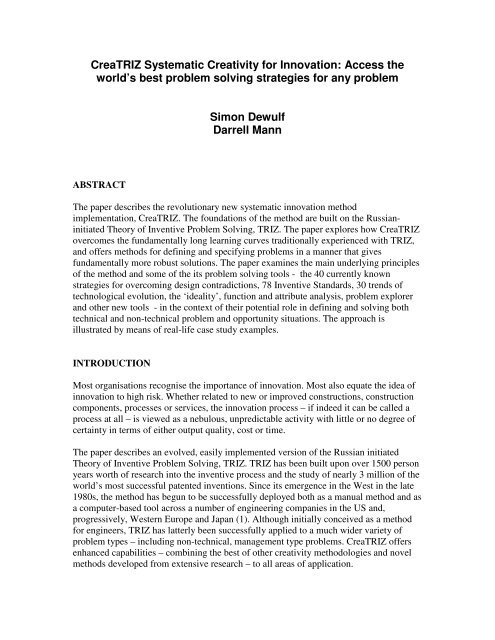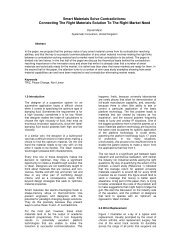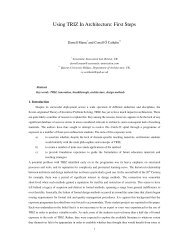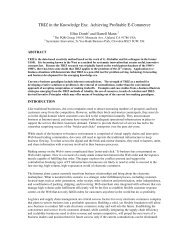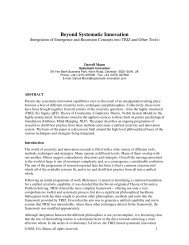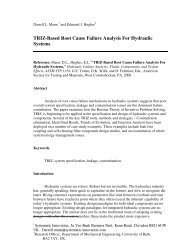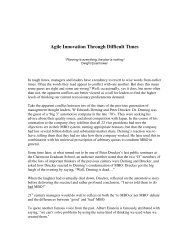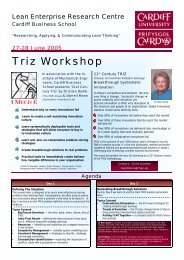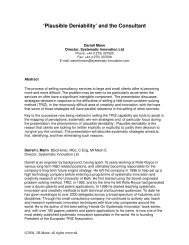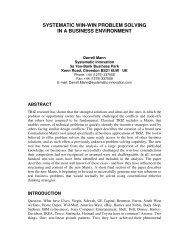CreaTRIZ Systematic Creativity for Innovation: Access the world's ...
CreaTRIZ Systematic Creativity for Innovation: Access the world's ...
CreaTRIZ Systematic Creativity for Innovation: Access the world's ...
Create successful ePaper yourself
Turn your PDF publications into a flip-book with our unique Google optimized e-Paper software.
<strong>CreaTRIZ</strong> <strong>Systematic</strong> <strong>Creativity</strong> <strong>for</strong> <strong>Innovation</strong>: <strong>Access</strong> <strong>the</strong><br />
world’s best problem solving strategies <strong>for</strong> any problem<br />
Simon Dewulf<br />
Darrell Mann<br />
ABSTRACT<br />
The paper describes <strong>the</strong> revolutionary new systematic innovation method<br />
implementation, <strong>CreaTRIZ</strong>. The foundations of <strong>the</strong> method are built on <strong>the</strong> Russianinitiated<br />
Theory of Inventive Problem Solving, TRIZ. The paper explores how <strong>CreaTRIZ</strong><br />
overcomes <strong>the</strong> fundamentally long learning curves traditionally experienced with TRIZ,<br />
and offers methods <strong>for</strong> defining and specifying problems in a manner that gives<br />
fundamentally more robust solutions. The paper examines <strong>the</strong> main underlying principles<br />
of <strong>the</strong> method and some of <strong>the</strong> its problem solving tools - <strong>the</strong> 40 currently known<br />
strategies <strong>for</strong> overcoming design contradictions, 78 Inventive Standards, 30 trends of<br />
technological evolution, <strong>the</strong> ‘ideality’, function and attribute analysis, problem explorer<br />
and o<strong>the</strong>r new tools - in <strong>the</strong> context of <strong>the</strong>ir potential role in defining and solving both<br />
technical and non-technical problem and opportunity situations. The approach is<br />
illustrated by means of real-life case study examples.<br />
INTRODUCTION<br />
Most organisations recognise <strong>the</strong> importance of innovation. Most also equate <strong>the</strong> idea of<br />
innovation to high risk. Whe<strong>the</strong>r related to new or improved constructions, construction<br />
components, processes or services, <strong>the</strong> innovation process – if indeed it can be called a<br />
process at all – is viewed as a nebulous, unpredictable activity with little or no degree of<br />
certainty in terms of ei<strong>the</strong>r output quality, cost or time.<br />
The paper describes an evolved, easily implemented version of <strong>the</strong> Russian initiated<br />
Theory of Inventive Problem Solving, TRIZ. TRIZ has been built upon over 1500 person<br />
years worth of research into <strong>the</strong> inventive process and <strong>the</strong> study of nearly 3 million of <strong>the</strong><br />
world’s most successful patented inventions. Since its emergence in <strong>the</strong> West in <strong>the</strong> late<br />
1980s, <strong>the</strong> method has begun to be successfully deployed both as a manual method and as<br />
a computer-based tool across a number of engineering companies in <strong>the</strong> US and,<br />
progressively, Western Europe and Japan (1). Although initially conceived as a method<br />
<strong>for</strong> engineers, TRIZ has latterly been successfully applied to a much wider variety of<br />
problem types – including non-technical, management type problems. <strong>CreaTRIZ</strong> offers<br />
enhanced capabilities – combining <strong>the</strong> best of o<strong>the</strong>r creativity methodologies and novel<br />
methods developed from extensive research – to all areas of application.
The paper presents some of <strong>the</strong> tools from <strong>the</strong> <strong>CreaTRIZ</strong>-based problem definition and<br />
problem solving methodology.<br />
The first section of <strong>the</strong> paper examines <strong>CreaTRIZ</strong> from <strong>the</strong> perspective of <strong>the</strong> problem<br />
solving tools <strong>for</strong> those previously unfamiliar with TRIZ. Subsequent sections <strong>the</strong>n go on<br />
to describe how <strong>the</strong>se tools have been integrated with o<strong>the</strong>r systematic innovation<br />
methodologies, and how <strong>the</strong> combined methods are beginning to be applied successfully<br />
across a number of disparate problem types.<br />
TRIZ BASICS<br />
According to its proponents <strong>the</strong> core findings of TRIZ research on <strong>the</strong> global patent<br />
database are that <strong>the</strong> world currently contains a very small number - some 40 - of<br />
Inventive Principles and that all technology evolution trends are predictable (4,5).<br />
TRIZ provides means <strong>for</strong> problem solvers to access <strong>the</strong> good solutions obtained by <strong>the</strong><br />
world’s finest inventive minds. The basic process by which this occurs is illustrated in<br />
Figure 1. Essentially, TRIZ researchers have encapsulated <strong>the</strong> principles of good<br />
inventive practice and set <strong>the</strong>m into a generic problem-solving framework. The task of<br />
problem definers and problem solvers using <strong>the</strong> large majority of <strong>the</strong> TRIZ tools thus<br />
becomes one in which <strong>the</strong>y have to map <strong>the</strong>ir specific problems and solutions to and from<br />
this generic framework.<br />
TRIZ<br />
GENERIC<br />
PROBLEM<br />
TRIZ<br />
GENERIC<br />
SOLUTION<br />
SPECIFIC<br />
PROBLEM<br />
SPECIFIC<br />
SOLUTION<br />
Figure 1: The Basic TRIZ Problem Solving Process<br />
By using <strong>the</strong> global patent database as <strong>the</strong> foundation <strong>for</strong> <strong>the</strong> method, TRIZ effectively<br />
strips away all of <strong>the</strong> boundaries which exist between different industry sectors. The<br />
generic problem solving framework thus allows problem owners working in any one field<br />
to access <strong>the</strong> good practices of everyone working in not just <strong>the</strong>ir own, but every o<strong>the</strong>r<br />
field of science and engineering.<br />
Successful use of <strong>the</strong> various TRIZ tools requires an approach dissimilar to o<strong>the</strong>r<br />
creativity methods. Reference 6 discusses <strong>the</strong> four paradigm shifts – Contradiction,
Ideality, Functionality, and Use Of Resources – most commonly observed as important in<br />
a TRIZ usage context. We confine our discussion here to <strong>the</strong> various tools and techniques<br />
underlying those paradigm shifts.<br />
Contradictions/Inventive Principles<br />
The Contradictions part of TRIZ is constructed on a comprehensive analysis of patents in<br />
which <strong>the</strong> inventor has successfully ‘eliminated’ design contradictions. In using <strong>the</strong><br />
patent database as a foundation, <strong>the</strong> analysis has inevitably been dominated by<br />
engineering solutions, and so <strong>the</strong>re is an inevitable degree of extrapolation involved in<br />
applying <strong>the</strong> tool to o<strong>the</strong>r solutions. Never<strong>the</strong>less, previous research has demonstrated<br />
that <strong>the</strong> exact same solution strategies – or ‘Inventive Principles’ - apply in non-technical<br />
(7) and biological (8) situations. Preliminary work relating <strong>the</strong> Principles to architectural<br />
solutions seems to fur<strong>the</strong>r bear out <strong>the</strong> relevance and scope of <strong>the</strong> original TRIZ research<br />
and reference 3 reports <strong>the</strong> results of an investigation to identify examples of <strong>the</strong><br />
Principles being used in architectural solutions. We list a number of examples <strong>for</strong><br />
Inventive Principle 4 here:<br />
Principle 4. Asymmetry<br />
A. Change <strong>the</strong> shape or properties of an object from symmetrical to<br />
asymmetrical.<br />
• Introduce a geometric feature which prevents incorrect usage/assembly of a<br />
component (e.g. earth pin on electric plug)<br />
• Corner bricks<br />
• Keystone<br />
• Coated glass or paper<br />
• Introduction of angled or scarfed geometry features on component edges<br />
• Non-circular section chimneys reduce drag against prevailing wind direction<br />
• Sloped roofing<br />
• High-flow gutter uses asymmetry to better control entry flow of rainwater from<br />
roof into down-pipe (30% more flow <strong>for</strong> a given entry area)<br />
• "Modern" planning as opposed to classical planning<br />
• Tongued and grooved flooring<br />
• T beam floor construction<br />
• Double doors where one leaf is wider than <strong>the</strong> o<strong>the</strong>r<br />
B. Change <strong>the</strong> shape of an object to suit external asymmetries (e.g. ergonomic<br />
features)<br />
• Human-shaped seating, etc<br />
• Take account of differences between left/right handed, male/female users<br />
• Finger and thumb grip features on objects<br />
• Aerofoil section delivers lift by having diffferent shapes on top and bottom<br />
surfaces<br />
• Pull-handles versus push-plates on doors<br />
• Site Planning to respect an individual site<br />
C. If an object is asymmetrical, increase its degree of asymmetry.
• Compound/multi-sloped roofing<br />
• Cable assisted cantilever roofs<br />
• Tilt and turn windows<br />
• Folding doors<br />
The 40 (currently known) Inventive Principles make useful brainstorming aids and,<br />
indeed, many TRIZ users simply use <strong>the</strong> Principles as a way of structuring an idea<br />
generation session. In cases where <strong>the</strong> prospect of brainstorming around 40 solution<br />
routes is a little daunting, TRIZ offers users a Contradiction Matrix to help reduce <strong>the</strong> list<br />
of principles to a more manageable three or four. The Matrix has again been constructed<br />
largely via analysis of engineering patents. Unlike with <strong>the</strong> Inventive Principles,<br />
subsequent research has shown that <strong>the</strong> Matrix is less relevant when extrapolated to o<strong>the</strong>r<br />
areas (9). Initial indications <strong>for</strong> its relevance to architectural problems suggest <strong>the</strong> Matrix<br />
has merit (2), but much work will be required to validate <strong>the</strong> tool be<strong>for</strong>e it can be used<br />
with any degree of confidence this setting.<br />
Meanwhile, we examine a short example here to demonstrate <strong>the</strong> mechanics of <strong>the</strong> tool<br />
and <strong>the</strong> useful solution directions it is very quickly able to deliver:<br />
The ‘flexible housing’ phenomenon is becoming increasingly important in an<br />
environment in which housing needs by occupants are changing ever more rapidly as a<br />
result of changing lifestyles and demographics. The ‘I want <strong>the</strong> house/room to be big<br />
AND small’ is a classic TRIZ contradiction problem. Very quickly, <strong>the</strong> method identifies<br />
<strong>the</strong> following strategies successfully employed by those facing <strong>the</strong> same problem in o<strong>the</strong>r<br />
sectors:-<br />
• Principle 17 ‘Ano<strong>the</strong>r Dimension’ – ‘where a design acts within a straight line or<br />
plane, make use of <strong>the</strong> un-used dimensions<br />
• Principle 7 ‘Nested Doll’ – ‘place objects inside one ano<strong>the</strong>r, or allow <strong>the</strong>m to pass<br />
dynamically through one ano<strong>the</strong>r’<br />
• Principle 15 ‘Dynamics’ – ‘where a structure is immobile, make it mobile’<br />
• Principle 4 ‘Asymmetry – as above<br />
Using <strong>the</strong>se as solution triggers ei<strong>the</strong>r alone or in combination, it becomes possible to<br />
identify a variety of possible solution opportunities:-<br />
A traditional Japanese house has no bedrooms: bedding is rolled out at night.<br />
Have multi-use spaces ra<strong>the</strong>r than a series of single-use inflexible rooms. This could be<br />
achieved by moveable storage walls or room dividers, or, <strong>for</strong> example a suspended<br />
sleeping plat<strong>for</strong>m which moves up and down.<br />
Roof spaces capable of being used by adjacent homes in a terrace – such that as, <strong>for</strong><br />
example, <strong>the</strong> space requirement in one household shrinks, <strong>the</strong> loft space can be ‘rented’ to<br />
an adjacent property requiring more space.
Ideality/Ideal Final Result<br />
TRIZ founder, Genrich Altshuller, identified a trend in which systems always evolve<br />
towards increasing ‘ideality’ and that this evolution process takes place through a series<br />
of evolutionary S-curve characteristics (4, 10). A key finding of TRIZ is that <strong>the</strong> steps<br />
denoting a shift from one S-curve to <strong>the</strong> next are predictable. This finding may be<br />
expected to play a significant role in helping organisations to predict <strong>the</strong> evolutionary<br />
potential of any given system or sub-system.<br />
The essential paradigm shift between a conventional design approach and <strong>the</strong> TRIZ<br />
approach is that while traditionally, problem solvers start from <strong>the</strong> knowns of today, <strong>the</strong><br />
concept of Ideality, employs a strategy in which <strong>the</strong> problem solver is asked to envisage<br />
<strong>the</strong> ‘ideal final result’ situation – in TRIZ terms that situation where <strong>the</strong> function is<br />
per<strong>for</strong>med without any resource, cost or harm – and to <strong>the</strong>n use that as <strong>the</strong> basis from<br />
which to work back to a physically realisable solution. This philosophy is illustrated in<br />
Figure 2.<br />
CURRENT<br />
SITUATION<br />
1… 2… 3…. n.…<br />
generation<br />
IDEAL<br />
FINAL<br />
RESULT<br />
Current<br />
Design<br />
….<br />
Intermediate<br />
solutions<br />
Function achieved<br />
without resource<br />
Figure 2: Proposed ‘Ideality-Based’ Improvement and Evolution Strategy<br />
As well as offering a successful evolution strategy and real problem solutions, it may also<br />
be noted that <strong>the</strong> method also provides a considerable amount of valuable long-term<br />
strategy definition data. We look here, however, at a simple application of <strong>the</strong> tool<br />
looking at novel façade design:<br />
Defining Ideal Final Result (IFR) as ‘achieve <strong>the</strong> function without (additional) resources’<br />
is intended to suggest <strong>the</strong> concept of <strong>the</strong> existing system ‘solving <strong>the</strong> problem by itself’.<br />
The important word here is SELF. Self is a very important word in a TRIZ problem<br />
solving context, and <strong>the</strong> idea of solving problems without complicating <strong>the</strong> system<br />
denotes a powerful step towards increased ideality. Reference 11 discusses <strong>the</strong> subject in<br />
more detail.<br />
We confine ourselves here to discussion of a simple two-step application strategy. Step<br />
one involves defining <strong>the</strong> required function. For example ‘clean façade’ or ‘assemble<br />
panel’. Step two introduces <strong>the</strong> word ‘self’ – self-cleaning, self-assembling, etc – which<br />
is intended to act not just as a useful solution direction, but also as a prompt to examine a<br />
functional database in order to establish whe<strong>the</strong>r anyone has successfully delivered such a
self-X solution in o<strong>the</strong>r fields. In <strong>the</strong> case of ‘self-cleaning’, <strong>for</strong> example, again<br />
‘someone, somewhere has already solved your problem, and we might thus quickly<br />
identify <strong>the</strong> Lotus Effect as a potential source of a solution. The Lotus Effect comes from<br />
<strong>the</strong> Lotus plant, which has been observed to possess effective self-cleaning properties<br />
(Figure 3). Reference 12 describes <strong>the</strong> first commercial application of a product based on<br />
<strong>the</strong> Lotus Effect in a paint with life properties purportedly well beyond previously known<br />
capability. In <strong>the</strong>ory, <strong>the</strong>re is no reason why <strong>the</strong> concept could not be applied to o<strong>the</strong>r<br />
relevant applications – self-cleaning glass (now without an additional coating layer), or<br />
roof-tiles, to name but two.<br />
Lotus leaf - micro-structure<br />
Lotus leaf - water droplet repulsion<br />
Figure 3: Close-up of Lotus Plant Demonstrating ‘Self-Cleaning’ Properties<br />
(Reference 12)<br />
Trends of Evolution<br />
The self-cleaning example brings us nicely on to an examination of <strong>the</strong> trends of<br />
technology evolution uncovered by TRIZ researchers during analysis of <strong>the</strong> global patent<br />
database. In Altshuller’s classical TRIZ, <strong>the</strong>re are 8 trends of evolution. In <strong>the</strong> full<br />
<strong>CreaTRIZ</strong> package, we have so far identified over 20 additional generic technology and<br />
business evolution trends. We will look at some of <strong>the</strong>m here from <strong>the</strong> perspective of<br />
<strong>the</strong>ir practical application in a problem solving context.<br />
We start with a trend from classical TRIZ, known as ‘Surface Segmentation’ (Figure 4).<br />
The trend pattern is illustrated as a left-to-right sequence of design evolutions. In <strong>the</strong><br />
majority of cases, <strong>the</strong> left-to-right sequence is related to time (although <strong>the</strong>re are<br />
occasional instances where systems are temporarily seen to evolve in <strong>the</strong> opposite<br />
direction), such that systems with features on <strong>the</strong> left hand end of <strong>the</strong> pattern occur be<strong>for</strong>e<br />
those on <strong>the</strong> right.
Smooth<br />
Surface<br />
Surface<br />
With<br />
Rib<br />
Protrusions<br />
3D<br />
Roughened<br />
Surface<br />
Figure 4: Surface Segmentation Trend<br />
Roughened<br />
Surface+<br />
Active<br />
Pores<br />
In a problem solving context, <strong>the</strong> trends offer up suggestions on how to improve <strong>the</strong><br />
benefits within a given design. In effect, <strong>the</strong> trend is presenting <strong>the</strong> problem solver with a<br />
message that ‘somewhere <strong>the</strong>re is a benefit in moving from left to right along <strong>the</strong> trend’.<br />
In some cases – and <strong>the</strong> surface segmentation is a good example – this demands a little<br />
faith from <strong>the</strong> user. In aircraft wing design <strong>for</strong> example, ‘conventional logic’ suggests<br />
that if ‘low drag’ is a good design aim, <strong>the</strong>n wing surfaces that are smooth are a good<br />
way of achieving that aim. The Surface Segmentation trend says, however, that adding<br />
protrusions should offer a potential benefit; and this is in fact what turns out to be <strong>the</strong><br />
case in that wings featuring ‘riblets’ tend to possess better drag characteristics than a<br />
smooth wing. Similarly a 3D roughened surface (a la shark skin) offers even greater drag<br />
benefits.<br />
Our self-cleaning Lotus plant from <strong>the</strong> previous case study likewise has demonstrated a<br />
benefit in evolving to a 3-dimensional surface. The Lotus also incorporates an active<br />
secretion; something <strong>the</strong> Lotus Effect paint has not yet managed to incorporate.<br />
The trick of using <strong>the</strong> Trends is to make <strong>the</strong> connections between <strong>the</strong> specific problem<br />
and <strong>the</strong> generic trends. In practical terms, this means examining a given design from<br />
different aspects and levels of focus in order to identify, <strong>for</strong> example, where ‘smooth’<br />
things exist – importantly this means zooming out to <strong>the</strong> macro level and zooming in to<br />
<strong>the</strong> micro or increasingly to <strong>the</strong> nano-level to find things that are smooth, or have<br />
protrusions in one direction, etc.<br />
By way of an example of <strong>the</strong> deployment of <strong>the</strong> trends in a problem solving context, we<br />
look now at ano<strong>the</strong>r two trends in <strong>the</strong> context of <strong>the</strong>ir possible applicability to <strong>the</strong> design<br />
of better facades. The first trend is ‘Space Segmentation’ – Figure 5.<br />
Monolithic<br />
Solid<br />
Hollow<br />
Structure<br />
Structure<br />
With<br />
Multiple<br />
Hollows<br />
Capillary/<br />
Porous<br />
Structure<br />
Porous<br />
Structure<br />
With Active<br />
Elements<br />
Figure 5: Space Segmentation Trend<br />
This trend may generate immediate connections with <strong>the</strong> evolution of bricks (where, <strong>for</strong><br />
example, <strong>the</strong> ‘active’ element could be a fire retardent property or some <strong>for</strong>m of<br />
insulating material). In order to use <strong>the</strong> trend to help <strong>for</strong>m better facades, however, we
need to pro-actively look <strong>for</strong> more useful connections. This will again involve us looking<br />
at <strong>the</strong> problem from a variety of different perspectives. By way of an admittedly extreme<br />
example of this we might zoom right in to examine an individual fibre of an insulation<br />
layer within <strong>the</strong> façade. If we are able to make this leap, we may see that <strong>the</strong> fibre is a<br />
solid – and hence is at <strong>the</strong> left hand end of <strong>the</strong> trend. The trend, <strong>the</strong>re<strong>for</strong>e, is suggesting<br />
that <strong>the</strong>re would be a benefit somewhere in making <strong>the</strong> fibres hollow. Practical produceability<br />
issues aside (although several industries have successfully – economically! – made<br />
small diameter hollow fibres), an immediate benefit of a hollow fibre is that it acts as a<br />
better insulator, while simultaneously using less material, and <strong>the</strong>re<strong>for</strong>e being less heavy.<br />
Animal fur as found on a bear offers a good example of how o<strong>the</strong>r areas – in this case<br />
nature – have already identified hollowness as a good solution direction.<br />
Now taking <strong>the</strong> opposite viewing perspective and zooming right out to look at an<br />
example of a glazed façade, we may see that <strong>the</strong>re are a good many systems that are at<br />
<strong>the</strong> ‘hollow structure’ stage of <strong>the</strong> trend – e.g. double glazing systems. Although <strong>the</strong><br />
‘multiple hollow’ trend might suggest use of triple glazing, <strong>the</strong> trend is pointing more<br />
towards <strong>the</strong> use of ‘foam glass’ structures. While <strong>the</strong>se may be some way away from<br />
practical reality in an architectural perspective, <strong>the</strong> final ‘active elements’ trigger has seen<br />
elegant application in a 1999 patent illustrated in Figure 6.<br />
The invention is focused on a critical solar energy in buildings control problem<br />
associated with <strong>the</strong> flow of radiation through <strong>the</strong> windows and <strong>the</strong> glass facades.<br />
Frequently, <strong>the</strong> energy and light needs inside <strong>the</strong> building do not correlate to <strong>the</strong> solar<br />
energy input, leading ei<strong>the</strong>r to overheating on sunny days or, if employing sun protection<br />
glass, to too low exploitation of <strong>the</strong> solar energy during <strong>the</strong> heating period. Although<br />
mechanical shading systems permit variable solar transmission, <strong>the</strong>y often incur intensive<br />
capital investment and maintenance and <strong>the</strong>re<strong>for</strong>e are expensive. Here is ano<strong>the</strong>r classic<br />
TRIZ contradiction; ‘I want <strong>the</strong> glass to transmit and reflect radiation’. Electro-chromism<br />
is a well known (if not widely applied) solution to <strong>the</strong> contradiction. The reason it is not<br />
widely applied is due to its complexity, cost and requirement <strong>for</strong> an energy input. The<br />
Figure 6 patent describes <strong>the</strong> use of a catalytic and reactive tungsten oxide layer inside a<br />
double glazing unit that manages to achieve <strong>the</strong> required photo-chromic characteristics<br />
completely passively. As such it offers an example not only of <strong>the</strong> Surface Segmentation<br />
trend, but also of <strong>the</strong> evolution towards ‘self’ activating systems.
Figure 6: US5864994: Glazing element, in particular <strong>for</strong> facing building facades<br />
A second trend offering potential façade evolution ideas is <strong>the</strong> Dynamisation trend<br />
illustrated in Figure 7. This trend has perhaps less immediate application, and yet <strong>the</strong><br />
existence of air curtain and light-locks represent ‘facades’ that have evolved to <strong>the</strong> right<br />
hand end of <strong>the</strong> dynamization trend. The message from <strong>the</strong>se examples is that with <strong>the</strong><br />
ideality concept suggesting <strong>the</strong> evolution of systems towards ‘achieving <strong>the</strong> function,<br />
without <strong>the</strong> resource’, if <strong>the</strong> function of <strong>the</strong> façade is merely to keep in heat or keep out<br />
unwanted intruders, <strong>the</strong>n immobile bricks and mortar solutions are less than ‘ideal’. Of<br />
course, where <strong>the</strong> functional requirements of <strong>the</strong> façade also include things like<br />
protection against <strong>the</strong> elements and structural stability, <strong>the</strong> structure is progressively<br />
likely to be immobile in nature. That isn’t to say that mobility isn’t a good thing to
achieve; merely that it is not a well established solution. Earthquake resistant structures<br />
are increasingly employing flexibility to cope with <strong>the</strong> loads imposed on structures.<br />
Immobile<br />
System<br />
Jointed<br />
System<br />
Fully<br />
Flexible<br />
System<br />
Fluid or<br />
Pneumatic<br />
System<br />
Field<br />
Based<br />
System<br />
Figure 7: Dynamisation Trend<br />
Geometric evolution (Figure 8) is ano<strong>the</strong>r commonly observed trend – it has a lot of<br />
commonality with <strong>the</strong> Ano<strong>the</strong>r Dimension Inventive Principle and is basically saying that<br />
<strong>the</strong>re is advantage in turning 2D things into 3D things. By way of example – guttering is<br />
usually constructed as a 2D extrusion; <strong>the</strong> geometric evolution trend is encouraging use<br />
of a non-constant section gutter – possible benefits are appearance, control of water flow,<br />
self-unblocking, etc.<br />
Point<br />
1D<br />
Line<br />
2D<br />
Plane<br />
3D<br />
Surface<br />
Figure 8: Geometric Evolution Trend<br />
In many senses, <strong>the</strong> aes<strong>the</strong>tic aspects of architecture are dominated by <strong>the</strong> effective use of<br />
all three dimensions determining <strong>the</strong> physical appearance of <strong>the</strong> structure. It does not<br />
appear likely that <strong>the</strong> geometric evolution trend, or <strong>for</strong> that matter, <strong>the</strong> Ano<strong>the</strong>r<br />
Dimension inventive principle have much to offer. Prompts by <strong>the</strong> method to use<br />
asymmetry and curvature (Inventive Principle 14) are perhaps a little more helpful, but it<br />
seems clear that TRIZ is currently offering little to help architects when it comes to<br />
aes<strong>the</strong>tic considerations.<br />
Function And Attribute Analysis<br />
Although <strong>the</strong> functionality aspects of TRIZ owe a significant debt to <strong>the</strong> pioneering work<br />
on Value Engineering, <strong>the</strong> method of defining and using functionality data is markedly<br />
different; sufficient at <strong>the</strong> very least to merit discussion as a distinct paradigm shift in<br />
thinking relative to traditional occidental thought processes. Three aspects are worthy of<br />
particular note:-<br />
1) The idea that a system possesses a Main Useful Function (MUF) and that any<br />
system component which does not contribute towards <strong>the</strong> achievement of this<br />
function is ultimately harmful. In a heat exchanger, <strong>for</strong> example, <strong>the</strong> MUF is<br />
to transfer heat to <strong>the</strong> working medium; everything else in <strong>the</strong> system is <strong>the</strong>re<br />
solely because we don’t yet know how to achieve <strong>the</strong> MUF without <strong>the</strong><br />
support of <strong>the</strong> ancillary components. (Systems may of course per<strong>for</strong>m several<br />
additional useful functions according to <strong>the</strong> requirements of <strong>the</strong> customer.)
2) In traditional function mapping, <strong>the</strong> emphasis is very much on <strong>the</strong><br />
establishment of positive functional relationships between components. TRIZ<br />
places considerable emphasis on plotting both <strong>the</strong> positive and <strong>the</strong> negative<br />
relationships contained in a system, and, more importantly, on using <strong>the</strong><br />
function analysis as a means of identifying <strong>the</strong> contradictions, ineffective,<br />
excessive and harmful relationships in and around a system. Function analysis<br />
thus becomes a very powerful problem definition tool.<br />
3) Functionality is <strong>the</strong> common thread by which it becomes possible to share<br />
knowledge between widely differing industries. A motor car is a specific<br />
solution to <strong>the</strong> generic function ‘move people’, just as a washing powder is a<br />
specific solution to <strong>the</strong> generic function ‘remove solid object’. By classifying<br />
and arranging knowledge by function, it becomes possible <strong>for</strong> manufacturers<br />
of washing powder to examine how o<strong>the</strong>r industries have achieved <strong>the</strong> same<br />
basic ‘remove solid object’ function. ‘Solutions change, functions stay <strong>the</strong><br />
same’ is a message <strong>for</strong>ming a central thread in <strong>the</strong> TRIZ methodology: People<br />
want a hole not a drill.<br />
The emphasis TRIZ places on functionality demands that engineers and scientists adopt a<br />
much more flexible approach to <strong>the</strong> way in which <strong>the</strong>y look <strong>for</strong> solutions to problems.<br />
The age of <strong>the</strong> specialist is coming to an end; it is no longer sufficient <strong>for</strong> mechanical<br />
engineers to only look <strong>for</strong> mechanical solutions to <strong>the</strong>ir problems when someone from,<br />
say, <strong>the</strong> chemical or software or social or political, etc sectors may already have<br />
discovered a better way of achieving <strong>the</strong> function being sought – Figure 9. This is again<br />
important in a mass-customization context.<br />
AERO/THERMO<br />
DYNAMIC<br />
MECHANICAL<br />
Problem<br />
CHEMICAL<br />
ELECTRICAL<br />
Solution<br />
Figure 9: Solution Spaces<br />
(add in a section on FAA tool – screenshot and define importance<br />
Resources<br />
Be<strong>for</strong>e leaving <strong>the</strong> subject of TRIZ trends it is worth noting an important connection with<br />
<strong>the</strong> ‘Resources’ part of <strong>the</strong> method. TRIZ encourages unprecedented emphasis on <strong>the</strong>
maximisation of use of everything contained within a system. In TRIZ terms, a resource<br />
is anything in <strong>the</strong> system which is not being used to its maximum potential. TRIZ<br />
demands an aggressive and seemingly relentless pursuit of things in (and around) a<br />
system which are not being used to <strong>the</strong>ir maximum potential. Discovery of such resources<br />
<strong>the</strong>n reveals opportunities through which <strong>the</strong> design of a system may be improved. The<br />
trends of evolution may thus be seen to offer lots of such opportunities. In essence any<br />
system or system component which is a solid or has a smooth surface, or is 2D, or<br />
immobile, or has a continuous action, etc is a potential resource. i.e. because it still has<br />
untapped evolutionary potential.<br />
SUMMARY<br />
1) The systematic innovation and creativity methodology bult into <strong>CreaTRIZ</strong>, is <strong>for</strong>med<br />
around four main pillars, contradictions, ideality, functionality and use of resources.<br />
2) <strong>CreaTRIZ</strong> contains a broad spectrum of problem definition and problem solving<br />
tools, several of which have been shown to be relevant and useful in an architectural<br />
context. The concepts of ideality and contradiction elimination are as relevant to<br />
architects as <strong>the</strong>y are to designers and problem solvers in any practical applicationoriented<br />
discipline.<br />
3) The 40 Inventive Principles and Trends of Evolution tools offer a relatively easy<br />
route into using TRIZ to help generate novel solutions to problem and opportunity<br />
challenges across <strong>the</strong> widest possible spectrum of application areas.<br />
REFERENCES<br />
1) TRIZ Journal, www.triz-journal.com<br />
2) Mann, D.L., O’Cathain, C., ‘Computer-Based TRIZ - <strong>Systematic</strong> <strong>Innovation</strong> Methods<br />
For Architecture’, paper presented at CAAD Future conference, Eindhoven, July<br />
2001.<br />
3) Mann, D.L., O’Cathain, C., ’40 Inventive (Architecture) Principles’, TRIZ Journal,<br />
July 2001.<br />
4) Altshuller, G. ‘<strong>Creativity</strong> As An Exact Science’, (Gordon & Breach, 1984)<br />
5) Salamatov, Y., ‘TRIZ: The Right Solution At The Right Time’, (Insytec BV, The<br />
Ne<strong>the</strong>rlands, 1999)<br />
6) Mann, D.L.,’The Four Pillars of TRIZ’, invited paper at Engineering Design<br />
Conference, Brunel University, June 2000.<br />
7) Mann, D.L., Domb, E., ’40 Inventive (Business) Principles With Examples’, TRIZ<br />
Journal, September 1999.<br />
8) Mann, D.L., ‘<strong>Creativity</strong> As An Exact (Biomimetic) Science’, paper presented at<br />
Biomimetics IV, Reading, September 1999.<br />
9) Mann, D.L., ‘Towards A Generic, <strong>Systematic</strong> Problem Solving and Innovative<br />
Design Methodology’, paper to be presented at ASME DETC12, New Hampshire,<br />
September 2000.<br />
10) Mann, D.L., ‘Using S-Curves and Trends of Evolution in R&D Strategy Planning’,<br />
TRIZ Journal, July 1999.
11) Mann, D.L., ‘Ideality and Self’, paper to be presented at TRIZ Future 2001, Bath,<br />
November 2001.<br />
12) http://www.botanik.uni-bonn.de/system/bionics.htm


